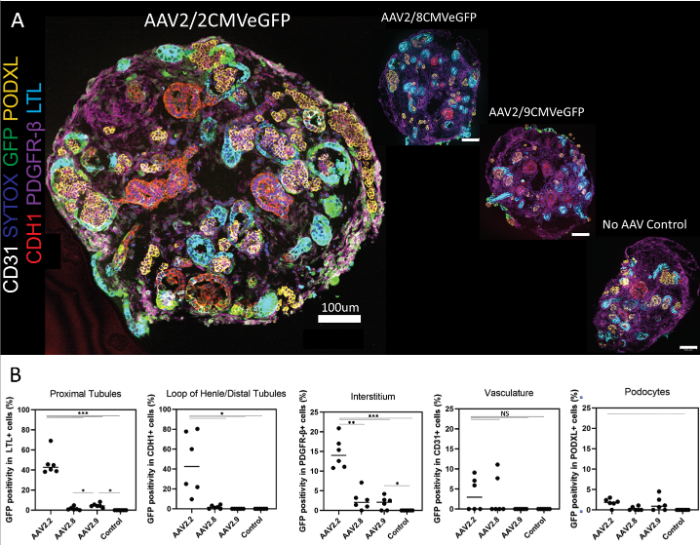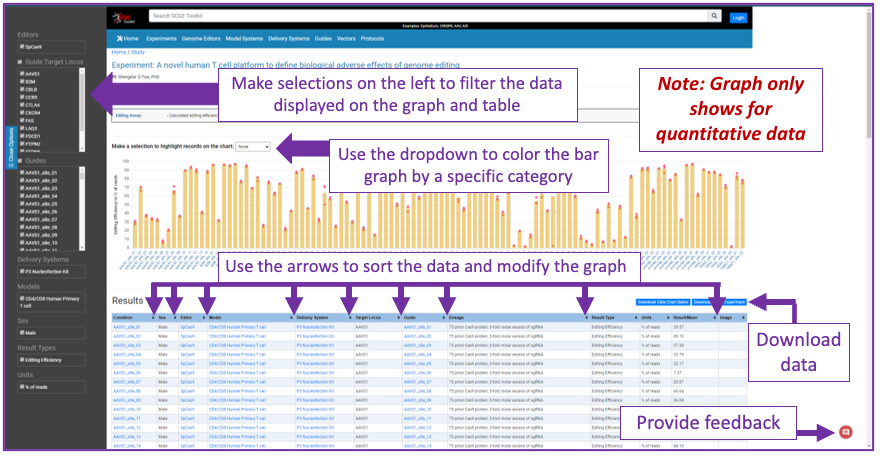Experiment: AAV tropism in kidney organoids derived from human pluripotent stem cells.
PI: Ryuji Morizane, MD, PhD
Description: Human kidney organoids generated from human ES and iPS cells are used to evaluate tropism of AAV2, AAV8, and AAV9 that express eGFP under CMV promoter. Organoids are exposed to AAVs at MOI 10^5 from differentiaiton day 21 to 28. Immunohistochemistry is performed to visualize transduced cells with staining for podocytes (PODXL), proximal tubules (LTL), loops of Henle and distal nephrons (CDH1), interstitial stromal cells (PDGFRb), and endothelia (CD31). AAV2/2 shows the highest transduction efficiency among three serotypes evaluated, and the GFP expression is highest in proximal tubular cells.
Delivery Assays:
Transduction efficiency was calculated by counting fluorescent cells (GFP) among LTL+ Proximal Tubule, CDH1+ Loop of Henle/Distal Tubule, PDGFR-B+ Interstitial, CD31+ Vascular, and PODXL+ podocyte cells.
Parent Project: Vascularized kidney organoids on chip for efficacy and toxicity testing of somatic genome editing
-
Other experiments in this project: 6
- Evaluation of DNA damage, cellular toxicity and inflammatory markers following saCas9 and gRNAs delivery by AAV2 in kidney organoids.
- Biomarker assays to evaluate toxicity and inflammation induced by AAVs in ES cell derived kidney organoids.
- AAV tropism in kidney organoids cultured under flow
- AAV2/2 transduction efficiencies in kidney organoids cultured under flow determined by FACS
- Biomarker assays to evaluate toxicity induced by AAVs in iPS cell derived kidney organoids.
- Delivery of saCas9 and gRNAs to nephron epithelia by AAV2 in kidney organoids.
Download: Submitted files
Select experimental variable to highlight records on the chart:
Note: Hover over the bars to view additional information
Results |
| Delivery Efficiency | ||||||||||||
|---|---|---|---|---|---|---|---|---|---|---|---|---|
| Condition | Cell Type | Age | Model | Delivery | Vector | Dosage | % GFP positivity in LTL+ cells | % GFP positivity in CDH1+ cells | % GFP positivity in PDGFR-B+ cells | % GFP positivity in CD31+ cells | % GFP positivity in PODXL+ cells | Image |
| Control | 33-44 | Human kidney organoid (stem cell-derived) | control | |||||||||
| AAV2/2 | 33-44 | Human kidney organoid (stem cell-derived) | AAV | AAV2/2CMVeGFP | MOI=10^5 | |||||||
| AAV2/8 | 33-44 | Human kidney organoid (stem cell-derived) | AAV | AAV2/8CMVeGFP | MOI=10^5 | |||||||
| AAV2/9 | 33-44 | Human kidney organoid (stem cell-derived) | AAV | AAV2/9CMVeGFP | MOI=10^5 | |||||||
 |
AAV tropism in kidney organoids derived from human pluripotent stem cells. (A) Immunostaining images of kidney organoids exposed to AAV2/2, 2/8, or 2/9 at MOI 10^5 for 1 week. 5 cell types in kidney organoids are visualized by staining for LTL (proximal tubules), PODXL (podocytes), CDH1 (loops of Henle~distal nephrons), PDGFRb (interstitial stromal cells), and CD31 (endothelia). (B) Graphs showing percentages of AAV transduced cells in each cell type in kidney organoids. |
